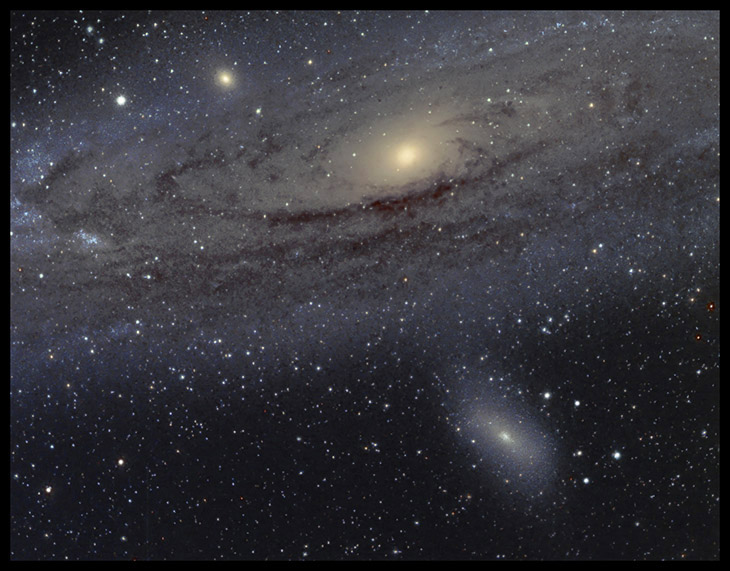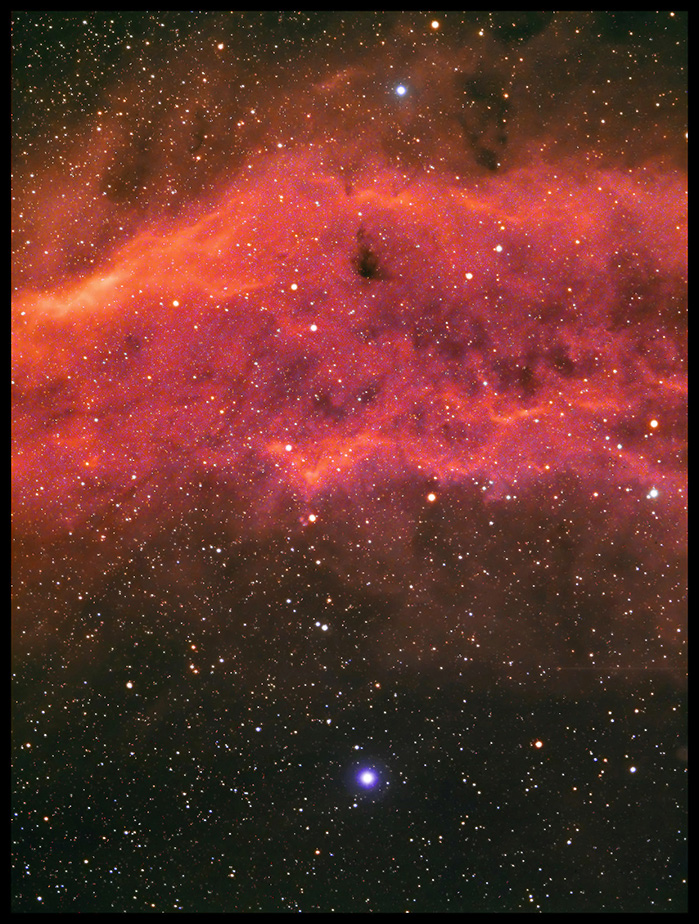11/19/2016. M31 has some tough bits. I wanted to see if I could get in one frame both the tidal tail streaming from its satellite galaxy NGC 205 (M110), and the "nuclear spiral" near M31's core that I accidentally found a few years ago. I didn't quite get both, but I think I know what needs to be done differently to pull out the spiral.
When the Moon rose, I returned to NGC 1499, the California Nebula, and shot all the hydrogen-alpha frames the night would allow, interupted for fifteen minutes of color (five each of RGB) somewhere along the way.
For both targets, I used the CCD oriented to 110-degrees (and cooled to -20C).

M31 and Satellites
TMB92SS at F4.4, SBIG ST2000XM
17x300s L + 7x300s R + 4x300s G + 4x300s B as luminance (2h 40m)
RGB for color, too.
Three hundred seconds is just too much for the core. The nuclear spiral is a swirl of gas and dust that lies well out of the plane of the galaxy, superimposed on the dominant spiral structure. It may be the remnant dust and gas from a galaxy M31 absorbed eons ago. It's of much lower contrast than the spiralling dust and gas in the plane (and well seen here). I averaged the RGB data along with the L hoping that might get me enough head-room to pull the nuclear spiral out. In the full-res, full-bit-depth files, it may have marginally succeeded. The dynamic range in this image has been unpleasantly compressed trying to extract that detail (and not quite getting it). Rather than belabor the post-processing, I'll shoot several 60s exposures in L and R (which is where I found the nuclear spiral before) and see if they will let me pull it out.
The tidal tail of the outer, fainter satellite galaxy came up nicely. It's interesting that it's noticeably blue, presumably a legacy of star formation triggered by the passage of the satellite through the main disk of M31 or perhaps its a spray of young stars swept along from M31's spiral arms.
When the waning gibbous Moon rose, I decided to take narrowband data of NGC 1499 rather than compromised whitelight data of M31. The same orientation (110 degrees) put useful stars on the guiding chip for both targets, so I can return to M31 tomorrow without messing up alignments. The sky improved after a couple of hours, and I interupted the H-a captures to take one sequence of 300s exposures in R, G, and B.

NGC 1499
17x900s H-a, 1x300s R, G, and B (4h30m)
same tech bits
By and by, I'll set up the usual larger images against a black background so the lower contrast aspects of each come through better. Wait until I get M31 worked out a little better. Let's see what happens tonight.
11/20/2016. Here's the plan: shoot darks until dark. Then take Ha, Oiii, and an Sii just to see what's there of the Bubble. Then go to M31 and take short exposures (30 and 60s) in L and R to try for the nuclear spiral again. Finish the night with IC 433 in Ha (mostly) with a few Oiii's tossed in. Use orientation 0-degrees for everything. There's a gap between M31 and IC 433 that I should try to fill with something. We'll see.
My deep-sky photos are made with a variety of sensors and optics. Deepest images usually come from a SBIG ST2000XM CCD behind a 10-inch Astro-Tech Ritchey-Chretien carried on an Astro-Physics Mach1GTO. The CCD is equipped with a CFW-10 loaded with Baader wide- and narrow-band filters. Camera control and guiding are handled by Maxim DL 5.12. A Canon 6D and a modded 50D find themselves mounted behind an Orion 10" F4 Newtonian or a 92mm Thomas Back refractor or a tiny but mighty AT65EDQ refractor, sometimes with Backyard EOS in control and PHD Guide keeping things on target. Really widefield photos are often made using the 6D and various camera lenses and an iOptron Skytracker mount. PixInsight does most of the heavy lifting in post-processing — alignment, stacking, gradient removal, noise-reduction, transfer function modification, color calibration, and deconvolution. Photoshop along with Focus Magic and a handful of other plugins get their licks in, too, especially when polishing for the web.
:: top ::